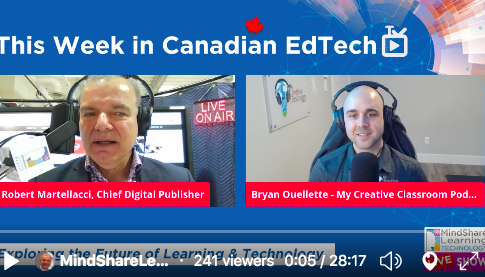While reflecting on our nine years of offering educators and students across this great land of ours an opportunity to provide us with a glimpse into their classrooms infused with teaching and learning using technology, I can honestly state that I have been encouraged. I’m not encouraged because great new tools are being used, though these new tools have indeed provided new and expanded avenues of learning, but rather, I have been encouraged by the deeper learning that has resulted because teachers have worked out how to leverage these tools into their pedagogy in extremely effective ways. I’m also encouraged because I see students taking charge of their learning. When these two things come together, we will begin to witness a revolution in teaching and learning. I think we’re on the precipice of such a revolution now. It was Seymour Papert who remarked that he wished to see children use technology to do things that we never thought possible before. I believe that children are doing those things now. It’s not widespread but it’s growing, and teachers are beginning to realize that technology is a necessary component to reaching out and engaging, empowering and teaching students how to become their own agents of change. We have started to witness a new paradigm and technology has become an integral part of this pattern of change across Canada.
I remember a high school in Markham using Stop Frame Animation to produce the winning video for our very first cross-Canada MindShare Learning Video Challenge. Remarkably, it still resonates with me for several reasons. Firstly, the video was student driven and created. The students at Markville High School showcased a series of animated still frames following a high student from home to school. It was life in the digital realm; it was what students were experiencing 9 years ago, and in honour to the students, it foreshadowed what we’ve come to learn about the power of technology in the lives of students. In fact, the students writing on the SMART Board in that video still resonates with me, especially the last script: “It’s About Us.” Or how about the Kindergarten classroom in the West that so powerfully represented what can be achieved with a dedicated, highly skilled teacher at the helm. Young students were blogging, using various tools to extend their learning. And they were excited! Or the teacher in New Brunswick engaging his students in real world physics learning outside in the snowy winter wonderland that this province on the East Coast of Canada so often experiences. The contexts are different, but the impact is the same. Innovative teachers using appropriate technology solutions to engage, empower and extend the learning of their students.
What have we learned about teaching and learning with technology in Canada? We’ve learned that our educators are world class and that they are innovating in powerful ways. We’ve learned that our students are engaged in real-world learning, and they’re hungry for more. We’ve learned that you cannot use technology without also teaching students that with this kind of power there comes great responsibility. Teaching digital citizenship is a necessity. We cannot forget to ensure that our students understand their need to use technology in responsible ways. We have also learned that technology has created a much smaller world. Classrooms can collaborate with other classrooms in other parts of the world, or engage in conversations with experts on various topics using Skype, or Google Hangouts, or some other form of electronic communication. We have also learned that students are able to solve real-world problems in profound and unique ways. And we know that students want to engage in the challenges that face our world today. With technology, this is, of course, possible. We have learned that the use of technology in Canadian classrooms is growing, and will continue to grow because of incredible teachers and students who are hungry for opportunities to engage their world in meaningful ways.
We are eager to see how all of the above will play out on the 10th anniversary of the MindShare Learning Video Contest next year. We expect that the new pedagogies that are emerging, and the deep learning that is occurring, will only grow broader and reach further across the educational landscape of Canada. And we know that we’ll yet again remain proud of our students and teachers and all that they have to offer to the 21st Century from a uniquely Canadian perspective. What will the next 150 years of teaching and learning look like in Canada? We can only begin to imagine!









